
United Kingdom
London, "the big smoke"![[Unesco]](/images/unesco-logo.gif)
![[+]](/images/icone-etoile.png)
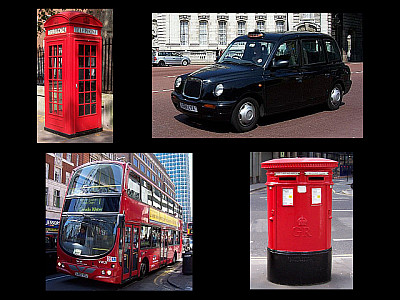
London is a major place in finance but also culture and art. It is the largest capital in Europe both for its population and its economy. The standard of living is as expensive as in Switzerland, and even more for real estate ! Although dynamic, there is some tranquility in the capital (if not being on the subway or in a traffic jam at rush hour of course !) : British phlegm is quite present and any stampede will be followed by a "sorry". And of course, impossible not to mention the famous red telephone boxes (although they are slowly replaced by more traditional booths), the red mailboxes, black cabs and "double decker" buses although the latter two have been modernized ! No high building here, everyone has their little house typically English : the result of this is that the capital is huge and much larger than any other European capital such as Paris. The historic center is fortunately mostly concentrated downtown. You had better forget the car in the center of London. Moreover, there are relatively few indications in the outskirt and a map is needed. While driving at night on the ring road, I happened to come across foxes ! Rather unexpected in a town, isn't it ?... Also note the presence of many cameras in the streets : they have already helped to solve several cases of assault (and as in any capital there are neighborhoods to avoid). The London slang is called cockney.
Mainlanders must soon lose the habit of starting to look on the left before crossing the street ! Here, as in all the British Isles one drive on the left. About the "underground" or "tube", we can read on the platform "mind the gap" which is sometimes justified ! there are a few stations with curves and spaces between the train and the platform so it is better to take care !
What can I add ? we can find "starbucks coffees" everywhere (though it is American...).
A bit of History : London was ravaged by the plague in 1665 before being devastated by a great fire of five days the year after. At the beginning of World War II the town suffered extensive German bombing : "the blitz".
Big Ben and Westminster palace
Westminster palace, along the Thames, is simply superb !
It was rebuilt in Tudor medieval style after a fire in 1834. It contains the two Houses of the British Parliament : the House of Commons (for the elected representatives) and the House of Lords (for the elected hereditary peer).
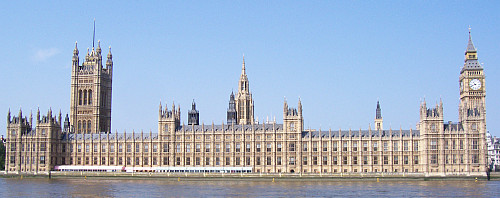
The clock tower, completed in 1859, is perhaps the most representative symbol of London (with tower bridge). The clock is set accurately before the beginning of each year with old penny coins. Indeed, a coin is added in the mechanism if the clock is fast whereas a coin is withdrawn if the clock is slow.
"Big Ben" is the bell (not the clock !) located in the clock tower. This name comes from Benjamin Hall, a tall man (hence the "big"), member of Parliament, who oversaw the construction of the building and the installation of the 13.5 tons bell. But there is another theory that the name would have been given from the boxer Ben Caunt...
Along the parliament, one can also see an equestrian statue of Richard I said "the lion heart". The outside decorations are worth a look. Parliament square is bordered with many statues of famous British figures including Winston Churchill, hero of World War II. In the adjacent park, a monument commemorates the abolition of slavery.
Tower bridge
This bridge dates back to the late 19th century and has been deliberately built in imitation of the Neo-Gothic style, but inside, it is at the forefront of the technology at the time of its construction. To add to the charm, it is a lift bridge...
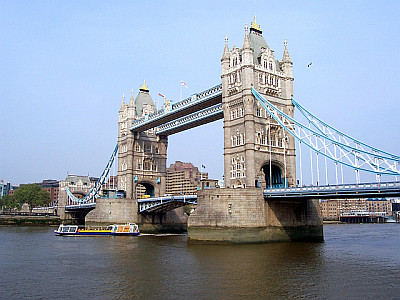
Tower of London
Legacy of William the Conqueror (Duke of Normandy), the tower of London is a castle surrounded by ramparts and a moat. It was both a fortress, a royal residence, and a prison. The Yeomen Warders, also known as Beefeaters, are the guardians of the tower. They are collared by tourists for a souvenir photo which doesnt seem to bother them ! A ceremony of the key is held every day at 9:45 p.m. but one need to have a reservation.
Inside the ramparts, we come across huge ravens. It became a habit since Charles II (in the 17th century) to keep at least six ravens as he was told that the kingdom would not be invaded as long as there are ravens at the Tower of London. In fact the wing tips of the ravens are cut to prevent them from flying and a dead raven is swiftly replaced to maintain their numbers.
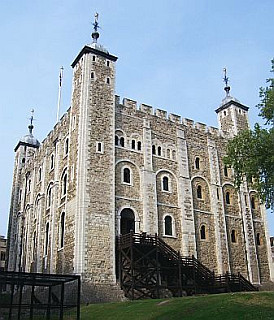
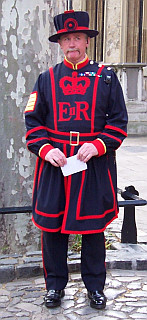
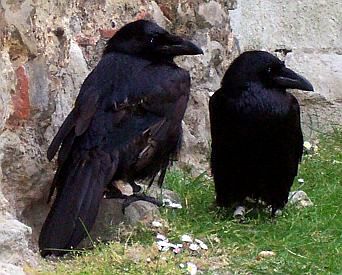
Inside the buildings, we find :
- Weapons and armours
- An amazing exhibition of royal crowns and regalia : I want a crown like that ! ;-)
- Instruments of torture as the tower was used as both a prison and a place of execution for several people including Henry VIII adulterers wives (Henry VIII is also the founder of the Anglican Church as he wanted to bypass the Pope and divorce his wife to marry another) : not really a gentleman this one !, or King Charles I overthrown by Cromwell.
- A museum of the Royal Fusiliers
- Beauchamp tower with graffiti left by prisoners
Let's add that that according to a legend, and because of the killings and tortures committed in these places, the tower would be haunted by several ghosts and even the ghost of a bear (the tower also hosted a menagerie).
St. Paul cathedral
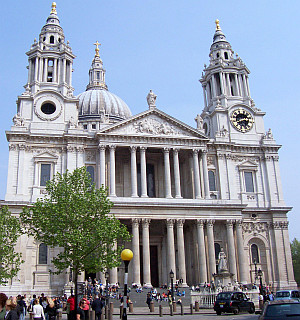
It is 365 feet high, so one foot (30,48 cm) for each day of the year.
One feature of the cathedral, designed by the architect Wren, is to have two symmetrical towers but only one has a clock ! The pediment represents the conversion of St. Paul
Inside (pictures are forbidden), one can find frescoes, a choir with canopy and a double dome : a inside dome and a outside dome. From the inside dome, one can access the whispering gallery whith its exceptional acoustics allowing to hear the slightest whisper.
Hence its name. From the outside dome wa have a nice view over the surroundings. Several personalities including Admiral Nelson are buried in the crypt.
Outside, there is a statue of St. Paul, the patron saint of the city.
Westminster abbey
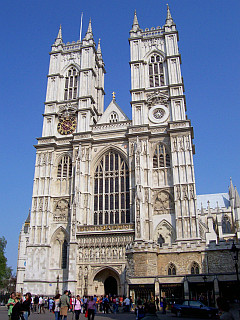
The admission is expensive but it has been the church of the coronation of England monarchs since the coronation of William the Conqueror in 1066 !
Westminster Abbey contains hundreds of graves including those of Elizabeth I, Edward I, Henry III, Henry VII, Edward III and Richard II... Some colourful mausoleums are superbs ! There is also the grave of an unknown soldier of the first world war. Poets, playwrights, and scientists are not forgotten : there are several memorials including one dedicated to Shakespeare, or to Charles Dickens, Rudyard Kipling, Lord Byron, as well as Newton for scientists... There is even a stone with the name of Darwin ! Rather odd to find the name of the father of the "evolution theory" in a church, although some say there is no incompatibility... Henry VII's chapel is superb for its vaults and stalls ! Too bad that the pictures are forbidden. About the coronation throne, the least we can say is that it is certainly original as it looks old and worn !
Westminster cathedral
Built with bricks in a Byzantine style in the late 19th century, this remarkable cathedral is decorated with marble and mosaics (including the chapels).
Buckingham palace
From the outside, I would say there is nothing extraordinary given its reputation. It was Queen Victoria who chose to reside at Buckingham Palace in the late 19th century. Besides there is an imposing monument representing Queen Victoria in front of the palace.
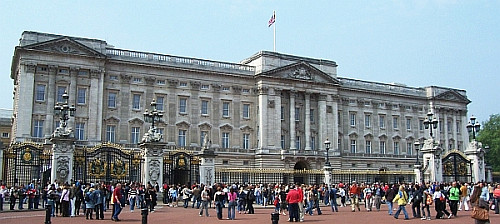
If not raining one can witness the changing of the guard at 11 a.m. every second day. The famous hat of the guards comes from soldiers of the Napoleonic armies (amazing...) and they are made with bear hair ! From the palace, we can keep walking towards the palace of St. James but entry is prohibited. However, going on the other side of the building, we come face to face with another guard on duty. It is a nice opportunity for a good photo shot.
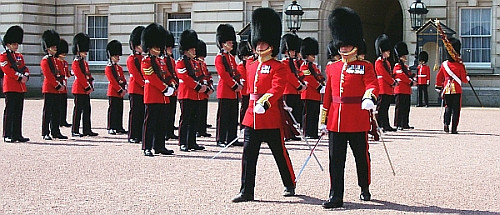
Whitehall
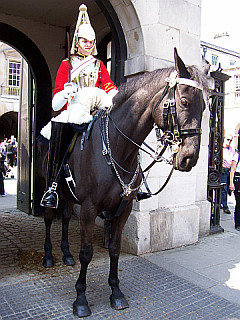
Whitehall is a wide avenue leading to Trafalgar Square from Westminster. There are many ministerial buildings as well as the 10 Downing Street which is the residence of the prime Minister.
But it is mainly the "Horse Guards" that attract attention !
Trafalgar square
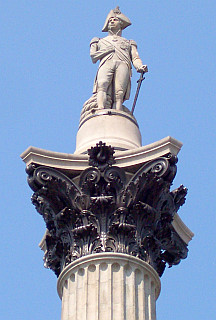
This is a great place with a column supporting the statue of Admiral Nelson, posthumous winner of the sea battle of Trafalgar (he was killed during this battle) against the allied Spanish and Napoleonic fleets. Four bronze lion statues were placed at the foot of Nelson's Column. The lion is the symbol of the United Kingdom.
There are thousands of pigeons looking for a few crumbs left by passersby !
Further, there are two large fountains and the building of the National Gallery.
A little further south, we go through the "Admiralty Arch". On the north of the square, we find the London Coliseum which is an opera. The globe of the roof rotates and is rather unusual for this type of building.
London eye
Although it is expensive and with an impressive queue, it is ideal for an aerial view of the city. And from there you can see that there are no high buildings : that is why it is very extensive ! Nice view over Westminster, unfortunatly we do not see Tower Bridge, situated after the bend of the Thames.
Also called the Millennium Wheel, the London Eye is the first wheel having capsules outside its circumference to allow a better view. There are 32 capsules.
Monument
The subway station 'monument' leads to a 62 m (203 feet) high doric column constructed from 1671 to 1677 to commemorate the Great Fire of 1666 that destroyed much of London. After climbing the 311 steps we get superb views over the City and Tower Bridge. A certificate is awarded downstairs after the climbing : nice !
The City
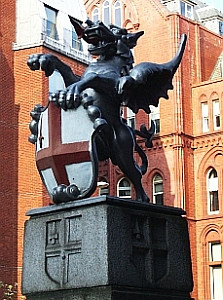
The City is the historical heart of London. Its motto is "God guide us" and its coat of arms includes St. George's cross (arms of England) supported by two griffins (which are rather represented as dragons) with the sword of St. Paul, the patron saint of the city. The griffin alone was also used to mark the boundaries of the City.
Destroyed by fire in 1666, the City has become a financial and business center among the most important in the world (it is now the second after Wallstreet in the United States).
Among the few towers, we can notice the Swiss Re Building nicknamed "the gherkin" because of its shape, and the Lloyd, which dates back to 1986 and was built by the architect of the Pompidou Center in Paris : all the pipes are built on the outside. As far as I am concerned, I don' t vote for it... Fortunately, the adjoining Leadenhall market is magnificent !
The stock exchange (including the old royal stock exchange) are located within walking distance of the main buildings.
Temple church
This ancient Templar church (1166) is located in a residential area where you can see the emblems of the lamb (a symbol of Christ) with the English flag and Pegasus (winged horse).
The Templar order is often represented by two knights sharing a horse, as depicted by a statue near the church.
Inside the church, we discover recumbent effigies of 13th century Knights Templar while being watched by many carved faces.
Obelisk of Cleopatra
On one bank of the Thames, we can see an obelisk from Heliopolis dating back to 1,500 B.C. Bronze sphinxes were added on two sides as decoration.
Piccadilly / Soho / China town
The bustling Piccadilly square reminds me of St.Michel square in Paris because they are both huge meeting places.
At one corner of the square there are neon signs and advertisements while in the center the statue of Eros has just fired its arrow ! who is going to be hit ? This fountain statue is also called Shaftesbury memorial in honor to the politician who forbade the labor of children in mines.
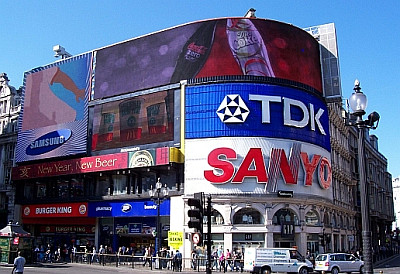
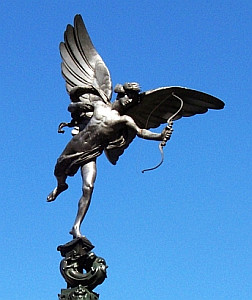
Going to the north, we access two typical neighborhoods :
- Soho with many cafes and restaurants along sex shops and peep shows...
- China town where inscriptions and newspapers are in Chinese. Large gates marks the entries. It is worth going specially for restaurants.
Covent garden
It is a bustling indoor market.
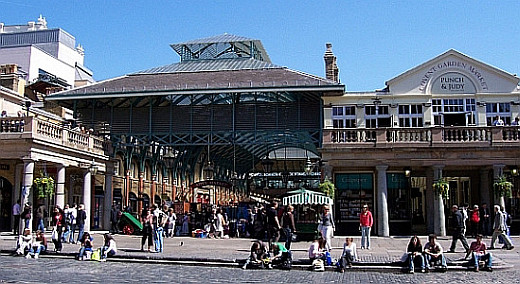
Holborn district and Inns court
The griffin delineates the border with the City. We can see the Law courts, which has a large clock, Twinings which is a great tea brand in London, Staple Inn which is one of the few (the only one ?) buildings still in the 16th century Elizabethan style in London, the entrance to the Church of St. Andrew which is flanked by two statues of schoolchildren well preserved : the British are careful.
Southwark cathedral
Cathedral since 1905, it is worth seeing. A memorial to Shakespeare recalls that the author was used to praying here.
Barbican center
It is a great neighborhood made with concrete and built after the destruction caused by the Blitz of World War II. As far as I am concerned I am not carried away ! Fortunately, there are some flowers.
Little Venice
This is the name given to this peaceful place where three canals meet. Lovely ! and we are still in London...
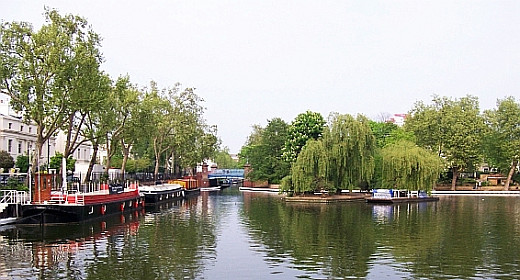
Leicester square
We can strike a pose in front of the statue of Charlie Chaplin or Shakespeare.
Nearby, there is an artery of cinemas and restaurants. One can also see a house with an oriel window.
Harrod's
It is a large shopping center specializes in luxury : doormen even open the doors ! At nightfall, the building, perfectly illuminated, take yet another dimension.
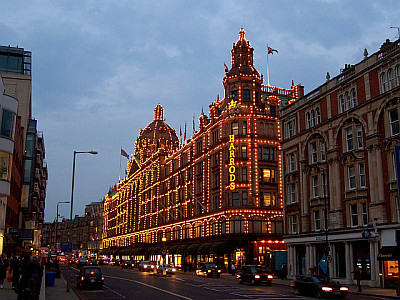
Hyde park & Kensington gardens
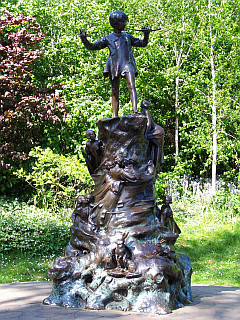
These two large parks are adjacent and separated by a lake. They are probably the nicest parks in London and I really enjoyed strolling there. There is a sand path for riders who wish to make their horses trot.
Near Marble Arch, the "speaker's corner" is a place where any speaker can come and talk about anything and be harangued by the crowd. To be seen but only on Sunday (too bad for me, I missed it...). South-east of the park we can see another arch : Wellington Arch.
An annular pool was built in tribute to Lady Di. But it is the huge memorial to King Albert, husband of Queen Victoria, which is the most impressive. She certainly loved him a lot to order such a great memorial ! To the four extremities, the statues represent 4 continents : Europe (symbolized by a bull), America (symbolized by a bison), Africa (symbolized by a camel) and Asia (symbolized by an elephant).
HMS Belfast
This is a cruiser built in 1938 which was used during the Normandy landings in 1944. It has been moved into a museum.
I know by experience that such a visit can take 2 to 3 hours (I visited a cruiser in France a few years ago), so not for that time as I had to go on with other visits...
Shakespeare's globe
William Shakespeare (1564-1616) is considered the greatest poet and writer from England. Who does not know the famous "To be or not to be, that is the question" of the play Hamlet ? Shakespeare's plays were created in a London theater called the Globe Theatre that burned down in 1613. The new theater has been rebuilt in 1996 with an open architecture. We can attend performances in the summer.
Sherlock Holmes
The famous detective of the novels and short stories by Sir Arthur Conan Doyle lived at 221B Baker Street. He was often accompanied in his investigations by Dr. Watson, and the reply "Elementary my dear Watson" is very well known. It turns out that baker street exists in London and a statue of Sherlock Holmes has even been built in his honor, as if he was a historical figure !...
A small museum is dedicated to him but apparently this would be a room set up to replicate the world of the detective.
Madame Tussaud
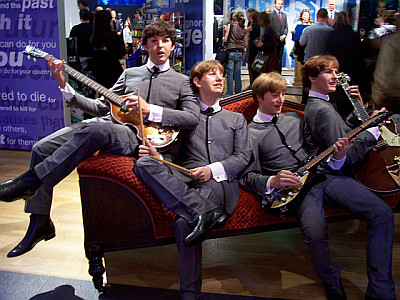
Of French origin, Madame Tussaud (1761-1850, born Grosholtz) learnt to make wax masks with a German artist, Curtius, for whom she worked as a cleaning woman in Bern. She began her first wax in France with those of Voltaire and Rousseau. During the French Revolution, she was sentenced to the guillotine because of her proximity with the nobility but she was granted a pardon for making death masks of revolutionaries or their victims. Gone to England to present her collections, she was blocked there because of the Napoleonic wars and finally settled in London.
Today, there are waxes of artists (the girls seem to appreciate Tom Cruise or George Clooney, while boys rather make for Kylie Minogue or Britney Spears), sportmen, historical figures and politicians.
The "Spirit of London" is a ride through time to discover the history of the capital. And for those who are not afraid of nightmares, there is the torture chamber ("chamber live"). Let's add that there are several Madame Tussaud's wax galleries in the world but the one in London is probably the most famous. Among the famous wax museums in the world, we also have the mus├ęe Grevin in Paris.
Nearby, we can take a walk in Regent's park (to go and see the gardens of the Queen).
Natural history museum
The building itself is remarkable. Arriving late (but it is free from 4:30 p.m. to 5:50 p.m.), I made a whirlwind tour. There are many types of animals, stones and even dinosaur bones. There is even an animated reconstruction of a Tyrannosaurus (named T. Rex)...
British museum
It is a great museum but dedicated only to Civilizations (no paintings here, one must go to Tate gallery ).
I particularly enjoyed the Egyptian gallery (for sarcophagi and mummies) and Assyrian gallery (with superb statues and friezes from Nimrud...). The Indian part is not bad at all ! The highlight of the visit is of course the Rosetta Stone.
For the Greek gallery, there are the remains of the Temple of Halicarnassus (one of the 7 wonders of the ancient world, that no longer exists), the discobolus, a bust of Alexander the Great...
There are a lot of other things to see as well as the Lindow man (visit closed for refurbishment during my visit), and it is not too much to expect spending a half-day in this museum...
Note also that the British Museum holds a crystal skull that dates back to the pre-Columbian period without explanations about its making with the means of that time, which raises all sorts of speculations as there would be several of them scattered around the world... Their authenticity remains in question.
More visits
-
Many other museums : Museum of London, Tate Gallery, Science Museum, National Gallery, Museum Victoria & Albert...
-
Greenwich : the neighborhood of the famous meridian from which we calculate the time differences. There is a maritime museum... I know no more as by lack of time I did not go there.
-
On my way, I saw the Hotel Russell and the least we can say is that it doesn't go unnoticed !
